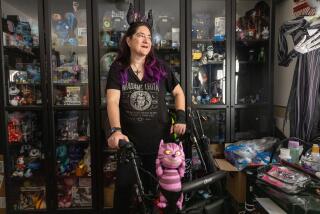Uncovering Obstacles : Tour Spotlights Problems City’s Disabled Residents Face
- Share via
PLACENTIA — A walk through the city with Dale Goodman can be an eye-opening experience.
Curbs are no longer just dividers between street and sidewalk but insurmountable barriers to people in wheelchairs and those using canes.
For people with arthritis and other crippling conditions, pedestrian signals at street corners are less a safety device than a frustrating reminder of other people’s impatience with their slower pace.
From her wheelchair, Goodman, who has multiple sclerosis, has a view of the city that is decidedly different from that of the casual pedestrian or driver. In an effort to share that view with city officials and the business community, Goodman and Dave Keup, both members of Placentia’s Handicap Advisory Committee, conducted a tour of the city Tuesday.
With two representatives from the Chamber of Commerce, Councilwoman Maria Moreno and residents Juliet Zaidi and Helen B. Moreno in tow, Goodman and Keup illustrated the many obstacles disabled residents face.
While the tour did not include any commercial buildings or stores, David Musgrove, president of the Placentia Chamber of Commerce, said some of what he witnessed could be applied to the business community.
“Businesses can police their area for overgrown shrubs,” Musgrove said. “They can put some sort of (device) over door jambs to make it easier for wheelchairs to pass over.”
Musgrove and Michael Beaver, executive director of the Chamber of Commerce, took part in the tour to learn more about how the federal Americans with Disabilities Act will affect local businesses.
“Our responsibility to the business community is to serve as a resource,” Beaver said. “We are committed to having information about the act to help businesses with the process of complying.”
The legislation, passed in July, 1990, requires that disabled people have equal access to employment opportunities, commercial and public buildings and transportation.
All companies must be in compliance with the act by 1995.
The first stop on the tour was the corner of Tafolla Street and Orangethorpe Avenue. The southeast corner of the intersection has a curb cutout, which leads to a crosswalk. But at the other end of the crosswalk the corner does not have a cutout. To cross Tafolla Street, Goodman had to travel about 100 yards down the street to a driveway, cross in the middle of the street, then come back up the other side.
“This is not an unusual situation,” Goodman said. “It is a fairly common occurrence.”
Continuing east on Orangethorpe, Goodman encountered another common situation. Just before reaching the crosswalk at an exit ramp from the Orange Freeway, Goodman was forced to stop. To her right was a utility meter and to her left was an overgrown bush. There might as well have been a fence, Goodman said.
“There’s a great cutout,” Goodman said, pointing to the sidewalk just ahead of her. “Too bad I can’t get to it.”
Utility poles, fire hydrants, meters and overgrown shrubs and trees can make a sidewalk impassable for someone in a wheelchair, on crutches or using a cane.
“I can’t push bushes aside because I need both hands to steer,” said Keup, who uses a motorized cart.
According to Musgrove, many business owners are concerned that complying with the Disabilities Act could put them out of business.
“It’s not a question of wanting to comply; some just can’t afford to,” he said.
More to Read
Sign up for The Wild
We’ll help you find the best places to hike, bike and run, as well as the perfect silent spots for meditation and yoga.
You may occasionally receive promotional content from the Los Angeles Times.






